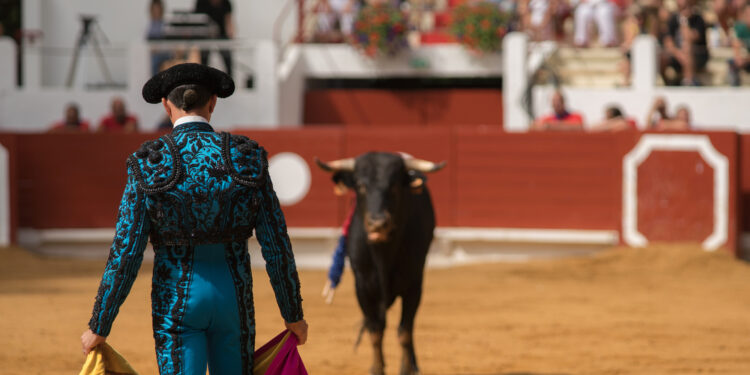Contents
Questo articolo è disponibile anche in:
The corrida is one of the most eagerly awaited and controversial spectacles. Deeply rooted in history and popular traditions, it reflects centuries of culture, rituals and social practices. It weaves together art, courage and discipline in an event that continues to inspire both fascination and debate.
Origins and spread
The roots of bullfighting go back to ancient practices tied to Mediterranean and Middle Eastern rituals that honored the bull as a sacred animal and a symbol of fertility and strength. In Minoan Crete (2nd millennium BC), ritual games such as taurokathapsia already celebrated or challenged bulls, while in Roman times, animal combats were staged in amphitheaters.
Modern bullfighting, however, was born in Spain in the 18th century. What began as an aristocratic pastime, with nobles on horseback testing their courage and skill against bulls, evolved into a popular spectacle. The transition to corrida on foot, with the matador as the central figure, marked the beginning of the highly ritualized structure still in place today.

Over time, bullfighting spread to Portugal, France, Mexico, Colombia, and Peru, carried along Spain’s colonial and cultural networks. Each country shaped the tradition differently: in Portugal the equestrian element remained central, in France it became more theatrical, and in Latin America it intertwined with religious and civic festivities, gaining an even broader social dimension.
Structure and characters
Bullfighting is a ritualized performance, carefully structured in stages with clearly defined roles. At the center of the arena are the matador – Spanish for “killer” – and the bull. The matador is the undisputed protagonist, responsible for directing the spectacle, confronting the animal, and bringing the contest to its conclusion.
Other figures play crucial supporting roles. The picadores (from picar, “to prick”) are mounted fighters armed with long lances, tasked with weakening the bull’s muscles and slowing its initial charge. The banderilleros (from banderilla, “little flag”) work on foot with agility, planting brightly decorated barbed sticks into the bull to spur its movements and further control its strength.
The bulls themselves are almost always of the Toro Bravo breed, raised in Spain through traditional methods that emphasize power, stamina, and temperament. Bred over generations solely for the arena, these animals embody both the allure and the controversy of bullfighting.

The circular arena is itself symbolic, ensuring spectators an unobstructed view of every movement. Each stage of the performance – from the bull’s ceremonial entrance to the dramatic finale – follows strict codes that demand discipline, technical mastery, and extraordinary courage from the toreros.
Variants in the world
Bullfighting has taken on distinct forms in the countries where it spread, adapting to local cultures and sensibilities. In Spain, its birthplace, it remains especially prominent in regions like Andalusia, Castile-La Mancha, Madrid, and Valencia.
In Portugal, the tradition evolved into a more acrobatic and animal-respecting version. The bull is not killed in the arena, and the cavaleiro (horseman) performs on horseback while groups of men known as forcados face the bull on foot with their own daring techniques—particularly in Alentejo and Algarve.
In southern France, in cities such as Nîmes, Arles, and Bayonne, the Spanish-style corrida is practiced alongside less violent variants like the course camarguaise, in which the bull is unharmed and the focus shifts to the agility and skill of the participants.
In Latin America, bullfighting was woven into the fabric of local festivities. In Mexico and Colombia – especially in Mexico City, Guadalajara, Bogotá, and Cali – corridas are held as part of religious and civic celebrations, accompanied by music, costumes, and rituals that enhance their communal dimension. In Peru, particularly in Lima and Trujillo, they are closely tied to patronal festivals and regional traditions.
In recent years, so-called “ethical” corridas or eco-corridas have emerged, where the bull is not seriously harmed. These spectacles highlight choreography and the toreros’ artistry, attempting to reconcile modern sensitivities with historical tradition.
Historically, bull-related rituals also appeared in parts of North Africa and Mediterranean islands such as Sicily and Sardinia, where local festivals and civic events testify to the wide diffusion of the practice.
These variations show how, while deeply Spanish at its core, bullfighting has adapted across continents, blending spectacle, ritual, and local identity into a global cultural phenomenon.
Controversy and debate
Despite its historical and cultural weight, bullfighting remains one of the most debated traditions. Critics focus on animal suffering and the ethical implications of the bull’s death. In many countries, animal rights groups have won restrictions or outright bans. Supporters, on the other hand, defend bullfighting as cultural heritage, inseparable from history and identity. Symbolic corridas and eco-corridas have emerged as compromises, seeking to balance tradition with greater respect for animals.
Even amid mounting criticism, bullfighting continues to stand as a complex cultural legacy – part ritual, part spectacle, part history – that provokes fascination, passion, and reflection wherever it survives.













